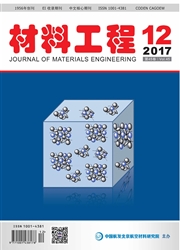

 中文摘要:
中文摘要:
通过等离子喷涂-物理气相沉积(PS-PVD)技术在3种不同工艺参数下制备7YSZ热障涂层。采用XRD和SEM分析涂层的相结构和微观组织,利用激光脉冲法测量涂层不同温度下的热导率。结果表明:通过调整工艺参数中电流的大小和等离子气体成分,可以制备截面呈柱状、致密层状和柱-颗粒状混合组织结构,表面呈"菜花"状或起伏的多峰状的YSZ热障涂层。涂层的相结构由粉末的单斜相氧化锆(m-ZrO_2)转变为涂层中的四方相氧化锆(t-ZrO_2),并保留至室温。在700~1100℃时,YSZ涂层的热导率随着温度的升高而增大。柱状晶结构涂层因具有较大的孔隙率,可以有效降低涂层的热导率,其热导率为1.0~1.2W·m~(-1)·K~(-1);而层状结构涂层由于比较致密,其热导率相对较高。
 英文摘要:
英文摘要:
The 7YSZ thermal barrier coating was prepared with three different process parameters by plasma spraying-physical vapor deposition(PS-PVD). The phase structure and microstructure of the coating were analyzed using XRD and SEM methods, and the thermal conductivity of coating was measured under different temperatures using laser pulse method. The results show that PS-PVD tech-nology can prepare YSZ thermal barrier coating with different structures of columnar section, dense la-mellar and column-particle mixed structure with surface ^cauliflower^ shape or undulating peaks by adjusting the process parameters, such as the current and plasma gas composition. Phase structure of 7YSZ coating is transformed from m_Zr02 powder to t_Zr02 coating in the process of preparation and stays in room temperature. The thermal conductivity of 7YSZ coating increases with the rising of tem-perature between 700-1100 °C , the columnar crystal coating with higher porosity can effectively reduce the thermal conductivity of coating and the thermal conductivity is 1.0-1. 2W m-1 K-1 ; while lay-ered crystal coating is dense with relatively higher thermal conductivity.
 同期刊论文项目
同期刊论文项目
 同项目期刊论文
同项目期刊论文
 期刊信息
期刊信息
